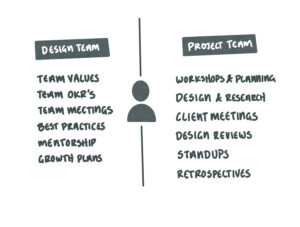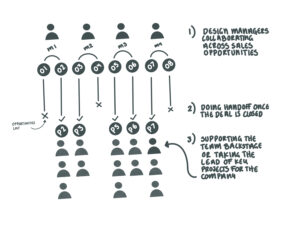Design leaders in technology consulting and services firms face common challenges when trying to get interesting projects for their team, assign the right people to those projects, and provide a network of support for designers to deliver and grow.
And when another discipline, such as engineering, vastly outnumbers your design team, these challenges are magnified – the projects are often focused on solution and delivery rather than problem and discovery. This unbalanced focus can cause design to be perceived as an add-on or an afterthought, limiting the spectrum of skills user-centric designers can put into practice.
Although this situation is not unique to us at Wizeline, through the years, our team has managed to grow rapidly (from 4 to 50+), work on research- and design-specific projects for clients, and become a spearhead for key accounts in the company’s portfolio. These are the most relevant DesignOps strategies the leadership team has followed to successfully scope, staff, and deliver as a design organization.
A centralized and embedded Design team
When it comes to design management and DesignOps, our team works under a centralized model popularized by Merholz & Skinner. Our sales and delivery teams raise requests for new or existing projects that need design work, so we, the design management team, take on those requests, look at our pool of designers, and assign people based on availability and skills.
This model works for us as part of a consultancy company – we act as an internal agency that staffs designers on projects ranging from a couple of months to a year in most cases. The benefits for our department are the ones accurately described by Merholz & Skinner:
- We have a solid team with a sense of identity, community, and shared values
- We gain expertise by working across a wide range of projects because, as opposed to product companies, we touch on various verticals, markets, and types of organizations (from startups to multinational companies)
- We are efficient and consistent with our outputs because we share design principles, standards, and best practices
- Our lines of authority are clear, making it easy for everyone to know who to approach for coaching, career development, and administrative matters
However, once we assign our designers to a project, they embed in their teams and contribute across the product life cycle:
- Running discovery phases through business and user research
- Supporting the definition and planning through strategy workshops
- Executing through iterative cycles until final delivery
While on their projects, designers continue having 1:1’s with their design managers, getting support from mentors and peers through design reviews, and attending our Design Team Meeting once a week to bond and maintain this sense of identity. This is what Merholz & Skinner call a Centralized Partnership but applied to a consultancy company – they get the best out of their two teams.
Activities and support for designers from the design team and their projects
Although this centralized but embedded model might sound ideal in principle, as with most principles, challenges surface once you put them into practice. These are the two that we have addressed through time:
Problem: Unclear design requirements for assignments
Every client defines and measures design their way. For example, when they ask for a Senior UX Designer, our definitions of job level expectations may not align, and the best way to find alignment is to have a conversation around:
- What they conceive as UX Design, Product Design, Strategic Design, Research, etc.
- The type of product or service they plan to build
- The makeup of their design team (if any) and how they work with other disciplines such as product management and engineering
- The value they expect to get in terms of skills, activities, and no-go’s (e.g., we don’t need research) by working with our team members
That said, the questions that help to surface this information should be asked before a contract is signed. Unless you are a designer or work with a diversity of design skillsets to understand our discipline’s nuances, those questions might not come to mind.
Problem: Disruptive handoffs from pre-sales to project teams
The second challenge is linked to the first one: what happens if you ask the right questions, assign the right team, and kick off the project by asking the same questions you asked during pre-sales? The short answer is: your service will look broken.
Your clients will suffer just as you suffer when a customer support agent transfers you to another area to solve your problem and the next person asks for your name, phone, and address again. Our clients perceive us as one company, not as a set of disjointed services that don’t talk to each other. We were aware of this situation, so we took on a couple of preventive actions for both of the challenges described.
Managers as Sales Practice Leads
Just as our designers are embedded into their projects from the beginning, the management team is embedded in every client opportunity that involves research or design work. We partner with our Sales and Solutions teams across the sales cycle to listen to our clients and put together the best proposals for them. We are even distributed by portfolios, making it easy for the sales team to know who to approach by providing experts in each portfolio. These are some of the things we do across the process:
- Join sales calls, pitch our design services, and help to shape project plans and statements of work
- Align with our clients on their design needs while keeping an eye on our bench
- Run short design-thinking workshops to explore and better define the scope of the opportunity at hand
- Put together teams based on technical skills (IxDA, Content Design, UI Design), non-technical skills (strategic thinking, synthesis, analysis), industry expertise (retail, media, telecommunications), and career paths
Every manager spends around 20% of their time on these tasks. We prioritize them because we know our involvement is critical for designers to feel challenged, motivated, and prepared once they start working on the project. It is not a perfect process, and not every project is an ideal fit for everyone, but we mitigate most of the risks with our involvement and this approach to DesignOps.
Lastly, our handoff is more effective: we pass on the torch by explaining the challenges and opportunities in a language our designers understand and value. Moreover, a design manager will staff herself with a percentage of her time if she believes her participation is key to the project’s success – this ensures proper knowledge transfer and puts a familiar face in front of the client to lead discovery and planning efforts. After a few months, she can step aside and become a Design Sponsor.
Managers as Design Sponsors
Introduced in 2019 by our former design director, David Fore, a Design Sponsor coaches our team backstage. They partner with delivery and project management to support operational tasks that are not intrinsic to the project’s execution but need to be addressed so the team can focus on their craft. In other words, a Design Sponsor clears the way for designers to do their work. These are some of their activities:
- Have recurring syncs with the design team to provide coaching and tools for their work
- Work with Delivery Directors on planning potential project extensions or adding new members to the team
- Work with Project Management on any adjustments on the timeline, activities, and deliverables
- Plan for possible rotations with minimum impact on the business
- Sync monthly with our client stakeholders to get feedback on the designers’ performance and proactively address any issues on either side
A manager will become a sponsor if they were part of the pre-sales phase and now take a non-client-facing supporting role, or if they worked on the project for a while, and now that their thought leadership is not needed, they step aside and let the team lead the way.
As you might see, there is some overlap between both manager and sponsor responsibilities. While the focus of the former is on the individual, the latter’s focus is on the team and how they function as a group. Constant communication is key, however, between these two to foresee and address any issues proactively.
Time distribution for Managers
As managers leading DesignOps, we wear many hats, so we try to allocate our time reasonably:
- Sponsorship (~2hrs/week): we sync with the teams we are sponsoring weekly or bi-weekly and remain on-call for any issues they need help with
- Sales opportunities (~5hrs/week): if someone has too much on their plate, other managers and myself jump in to share the load
- Project leadership (~20hrs/week): whenever a manager leads a project, they stop working on sales opportunities and delegate to another manager or me
- People management (~18 – 20 hrs/week): we spend half of our time developing growth plans, doing coaching, participating in promotion cycles, team bonding, and administrative tasks
Individual contributors also have a mentor assigned, who, along with their managers, project sponsors, and leads, provides a support network across different contexts. We also hold office hours every week open to anyone, and I have skip-level 1:1s to make sure we are not missing essential topics to address.
Managers across sales opportunities and projects
What’s next?
These actions alone allow us to prevent issues that would be more difficult to fix down the road, proactively support our designers on their projects, and drive any necessary changes that benefit both our people and our clients.
What’s next is to extend this DesignOps model to other parts of our organization, make our work repeatable, and hire for the roles that will support the sales cycle more efficiently.
Brand and Marketing Design
As of today, our team has worked with marketing as one of our clients, taking on design requests and delivering on specific deadlines, but our marketing team is growing, and big projects are forecasted from this team.
We will soon embed some of our designers into the marketing team instead of treating marketing as a client. This way, they will take a more active role in the planning and execution but report to our department and get support from any designer as they work on their projects. Design and Marketing leaders will partner to provide effective coaching and mentorship, co-create career ladders for the roles, and collaborate during hiring and promotion cycles.
Effective Documentation
By being centralized, our team organically shares the challenges they face as designers, creates connections to get support based on each individual’s expertise, and promotes best practices to advance our discipline.
There are, however, a couple of things we still want to do on this front:
- Documentation standards: we are working on a framework to make our projects available and easily scannable by others, even those outside our team. Our Senior Visual Designer, Chisa Tanaka, is currently defining the guidelines for documenting our work across projects through the tools that most people (and not only designers) use every day.
- Case studies: we started documenting our case studies last year with two goals in mind: to showcase our expertise to potential clients and our community, and because they are an excellent tool for our design team to look through and understand how people have solved similar problems in the past. This is an ongoing effort that is already allowing us to reuse artifacts and reduce lead times.
Experience Engagement Lead
Our design team is growing along with the company. Every day we see more opportunities that need design assessment. Rather than continue with design managers as Sales Practice Leads, we have decided to hire an Experience Engagement Lead focused only on sales, so design managers can focus on our people, our team’s culture, and our practices.
The XEL will be the link between our team and the sales team. They will support every sales opportunity involving design, pitch our services and offerings, create plans for our designers to succeed on their projects, and inform hiring and staffing with the skills and seniority needed on each project. This person will report directly to the Design Director and grow our Business Design practice by portfolio.
Closing
As Design Consultants, we understand that what we do in DesignOps before and after the service is as essential as the service itself. Our client’s experience starts way before the contract is signed. If you are a design leader looking for ways to provide the best opportunities for your people, invest your time in these things:
- Insert yourself in the pre-service
- Partner with other teams
- Take part in the definition and scoping of the projects that will make your teams (and also your clients) successful
- Don’t forget about the people and support your team along the way
Once you prove the value of these design team strategies to the business, you should hire for more specialized roles to scale your practice and continue growing your team.








